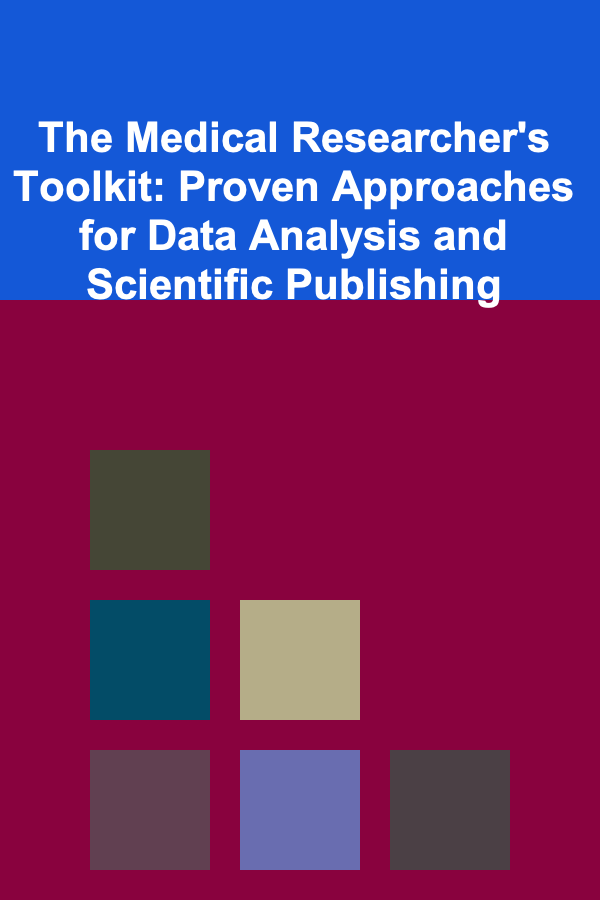
The Medical Researcher's Toolkit: Proven Approaches for Data Analysis and Scientific Publishing
ebook include PDF & Audio bundle (Micro Guide)
$12.99$9.99
Limited Time Offer! Order within the next:

Medical research is a field that constantly evolves, requiring researchers to not only possess a deep understanding of their specialized subject matter but also to be skilled in the tools and techniques for data analysis and scientific publishing. Whether you're conducting clinical trials, epidemiological studies, or laboratory research, the ability to analyze complex data and communicate findings effectively is crucial. This actionable guide will walk you through some of the most effective approaches for data analysis and scientific publishing, providing a toolkit that medical researchers can use to enhance the quality and impact of their work.
Data Collection: Foundation of Medical Research
Before diving into data analysis, it's essential to ensure that your data collection methods are sound. In medical research, the quality of your data will directly influence the accuracy of your analysis and the reliability of your conclusions.
Designing Robust Studies
The foundation of any reliable medical research is a well-designed study. Your research question should guide the study design, which may include randomized controlled trials (RCTs), cohort studies, case-control studies, or cross-sectional studies, depending on the nature of your investigation.
- Randomized Controlled Trials (RCTs): These are often considered the gold standard for clinical research. Randomization reduces the risk of bias by ensuring that treatment groups are comparable.
- Cohort Studies: Used to observe the natural progression of a condition or disease, cohort studies are particularly valuable for examining long-term effects.
- Case-Control Studies: These studies are effective for investigating the causes of rare diseases or conditions, comparing those with and without the condition of interest.
- Cross-Sectional Studies: These studies provide a snapshot of data at a single point in time, making them useful for understanding the prevalence of a disease in a population.
Ensure your study design minimizes biases, such as selection bias, recall bias, and confounding variables, which can distort your results.
Data Collection Methods
Medical data can come in many forms: clinical observations, laboratory results, patient surveys, genetic sequencing, and more. The method of data collection should be standardized and validated to ensure that it accurately captures what is being measured.
- Clinical Measurements: Ensure that measurements like blood pressure, glucose levels, or heart rate are taken consistently across all participants.
- Patient-Reported Outcomes: For patient surveys or questionnaires, use validated instruments such as the EQ-5D or the Visual Analog Scale (VAS) to ensure the reliability and validity of the data.
Data Analysis: Tools and Techniques
Once the data is collected, the next step is analysis. Effective data analysis is crucial for deriving meaningful insights from your study. The tools and techniques you choose will depend on the type of data you're working with and your research questions.
Statistical Software and Tools
The use of specialized software tools is essential for analyzing complex medical data. Some of the most widely used statistical software packages include:
- SPSS: Popular in the healthcare and social sciences fields for analyzing survey data, clinical trial data, and epidemiological studies.
- R: An open-source programming language with powerful statistical and data visualization capabilities. R is particularly useful for handling large datasets and performing complex statistical analyses.
- SAS: Often used in clinical trials, SAS is a statistical package that excels in data manipulation, analysis, and reporting.
- Stata: Stata is another popular tool for medical research, particularly for its data management and regression modeling capabilities.
- GraphPad Prism: Particularly useful for biostatistical analysis and creating clear, publication-ready graphs.
Statistical Techniques
Medical research often involves analyzing large datasets with numerous variables. The most common statistical techniques used in medical research include:
- Descriptive Statistics: These summarize and describe the features of a dataset, including measures of central tendency (mean, median, mode) and variability (standard deviation, range).
- Inferential Statistics: These allow researchers to make conclusions about a population based on a sample. Common techniques include hypothesis testing (e.g., t-tests, chi-square tests) and confidence intervals.
- Regression Analysis: Used to model relationships between a dependent variable and one or more independent variables. Linear regression is commonly used, but logistic regression and Cox proportional hazards models are often used in medical research for binary or survival data.
- Survival Analysis: This is crucial in clinical trials and cohort studies where the time to an event (such as death or disease recurrence) is a key variable. Techniques such as Kaplan-Meier curves and Cox regression are widely used.
- Multivariate Analysis: When analyzing multiple variables simultaneously, multivariate techniques like principal component analysis (PCA) or factor analysis help uncover underlying patterns in the data.
Handling Missing Data
Missing data is a common issue in medical research and can lead to biased results if not handled properly. Several approaches can be used to manage missing data:
- Imputation: Methods such as mean imputation, multiple imputation, or regression imputation can be used to estimate missing values based on existing data.
- Sensitivity Analysis: This involves checking how the results change when missing data is handled in different ways.
Using proper methods for handling missing data ensures that the conclusions drawn from your analysis are as robust and reliable as possible.
Scientific Publishing: From Data to Manuscript
Once your analysis is complete, it's time to communicate your findings to the broader scientific community. Effective publishing not only involves writing a compelling manuscript but also selecting the right journal, adhering to ethical standards, and preparing for peer review.
Writing a Strong Research Paper
The structure of a well-organized medical research paper is crucial for communicating your findings clearly. A typical research paper includes the following sections:
- Abstract: A concise summary of the research, including the background, methods, results, and conclusions. The abstract should be a stand-alone piece that provides an overview of your study.
- Introduction: This section provides background information, including a literature review and the research question. It should clearly justify the study and explain its relevance.
- Methods: This section describes the study design, data collection, and analysis methods. It should be detailed enough for another researcher to replicate the study.
- Results: Present your findings here, including tables, figures, and statistical analysis. Avoid interpreting the results in this section; save that for the discussion.
- Discussion: This is where you interpret your findings in the context of existing literature. Discuss limitations, implications, and potential areas for future research.
- Conclusion: Provide a concise summary of the key findings and their potential impact on the field.
Choosing the Right Journal
Selecting the right journal for your research is critical for maximizing its visibility and impact. Consider the following factors when choosing a journal:
- Scope and Focus: Make sure the journal's scope aligns with the topic and objectives of your research.
- Impact Factor: The impact factor reflects the frequency with which articles from the journal are cited. Higher impact factors are often associated with greater visibility and prestige.
- Audience: Consider whether the journal's readership includes the clinicians, researchers, or policymakers who would benefit most from your findings.
- Open Access vs. Subscription-Based: Open access journals are freely available to the public, increasing the potential for citations and wider dissemination of your research. However, they may have higher publication fees.
Peer Review Process
Most reputable journals employ a peer review process where independent experts evaluate the quality of your research. Here are some tips for preparing for peer review:
- Be Prepared for Criticism: Reviewers will often provide constructive feedback to improve the quality of your paper. Be open to criticism and use it to enhance your work.
- Respond Thoughtfully: When addressing reviewer comments, provide clear, evidence-based responses. If you disagree with a reviewer's comment, explain your reasoning respectfully.
- Revise and Resubmit: Most papers undergo at least one round of revisions. Use this opportunity to address the reviewers' concerns and improve the clarity and quality of your manuscript.
Ethical Considerations in Publishing
Medical researchers must adhere to strict ethical guidelines when conducting research and publishing results:
- Informed Consent: Ensure that participants in clinical studies provide informed consent, understanding the risks and benefits involved.
- Data Integrity: Never manipulate data or selectively report results. Research should be transparent and reproducible.
- Conflicts of Interest: Disclose any potential conflicts of interest, such as financial relationships with pharmaceutical companies or other organizations.
Maximizing Impact: Disseminating Research Beyond Publishing
Publishing in a peer-reviewed journal is just the beginning. To maximize the impact of your research, you should also disseminate your findings through other channels.
Conferences and Symposia
Presenting your research at medical conferences allows you to share your findings with your peers, receive feedback, and build professional networks. Conferences also offer the opportunity to engage with other researchers and stay updated on the latest advancements in the field.
Engaging with the Media
If your research has the potential to influence public health or clinical practice, engaging with the media can help raise awareness and ensure your findings reach a broader audience. Work with your institution's public relations team to prepare press releases or media interviews.
Social Media and Blogs
Social media platforms like Twitter and LinkedIn, as well as specialized academic networks like ResearchGate, can help you share your research with a wider community. Writing blog posts or sharing summaries of your research can also help translate complex findings into accessible formats for the general public.
Conclusion
Medical research is a multifaceted process that requires a robust set of tools and techniques. From collecting reliable data to conducting rigorous analysis and publishing your findings, the path to impactful medical research involves careful planning, ethical integrity, and effective communication. By mastering the skills in data collection, analysis, and publishing, you not only enhance the quality of your research but also contribute to advancing the field of medicine and improving patient outcomes worldwide.
Reading More From Our Other Websites
- [Organization Tip 101] How to Utilize Community Resources for Financial Help
- [Personal Care Tips 101] How to Use Body Wash for a Healthy Skin Barrier
- [Organization Tip 101] Essential DIY Tools Every Homeowner Should Have for Maintenance
- [Personal Care Tips 101] How to Shave Your Back with a Razor: Tips and Techniques
- [Organization Tip 101] How to Involve Children in Time Capsule Creation
- [Organization Tip 101] How to Prepare Your Subfloor for New Flooring Installation
- [Personal Care Tips 101] How to Choose the Best Plant-Based Protein Sources for Muscle Building
- [Personal Care Tips 101] How to Find a Sunscreen That Won't Clog Pores
- [Weaving Tip 101] Eco-Friendly Weaving: Sustainable Fibers & Green Techniques for DIY Projects
- [Horseback Riding Tip 101] Comparing Horse Riding Insurance: What to Look for in the Fine Print

How to Avoid Scams and Protect Your Finances Online
Read More
How to Handle Pet Separation Anxiety
Read More
How to Organize Your Pantry to Save Space and Time
Read More
How to Save for Retirement While Paying Off Debt
Read More
How to Use Rolling Carts for Mobile Storage Solutions
Read More
What Should You Know About Organizing Your Bathroom Products?
Read MoreOther Products

How to Avoid Scams and Protect Your Finances Online
Read More
How to Handle Pet Separation Anxiety
Read More
How to Organize Your Pantry to Save Space and Time
Read More
How to Save for Retirement While Paying Off Debt
Read More
How to Use Rolling Carts for Mobile Storage Solutions
Read More